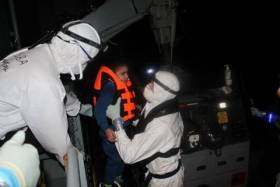Displaying items by tag: Migrant Refugees Rescued
Search And Rescue of Almost 100 Migrant Refugees Tasked to LÉ Samuel Beckett
#MigrantRescues – Two search and rescue missions (SAR) tasked by LÉ Samuel Beckett last week saved almost 100 migrant refugees off the Libyan coast.
According to the Naval Service the most recent SAR took place on Friday night following a request from the Italian Maritime Rescue Co-Ordination Centre. LÉ Samuel Beckett located and rescued a total of 50* migrants from a rubber 25 nautical miles north-west of Tripoli. The rescue operation began at 8.05pm and all migrants were taken on board LÉ Samuel Beckett by 10.20pm. The rescued persons were transferred to the NGO vessel Bourbon Argos.
Three days previously on the Tuesday, LÉ Samuel Beckett was also deployed by the Italian authorities to locate a total of 40* migrants. Again this incident involved a rubber vessel during a the rescue operation that was conducted 44 nautical miles north east off the Libyan capital. The operation began at 11am and all migrants were taken on board the OPV90 class vessel by 1.30pm. The 40 rescued persons were transferred to another NGO vessel, the Aquarius.
This brings to 2,310* migrants rescued by the LÉ Samuel Beckett since it deployed to the Mediterranean area of operations on 23 September of this year.
*Figures released on the days for both SAR operations are provisional until confirmed by the Italian authorities.





























































